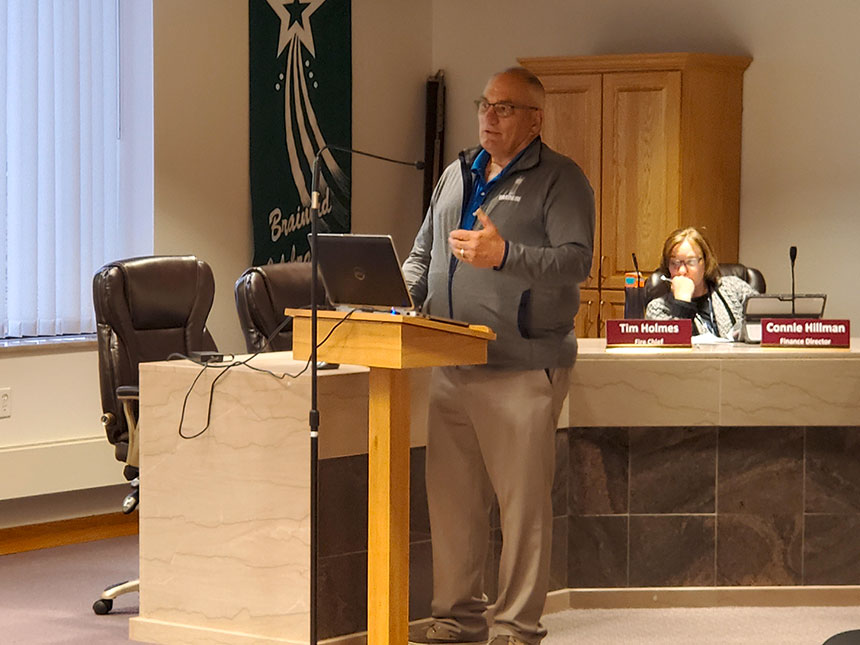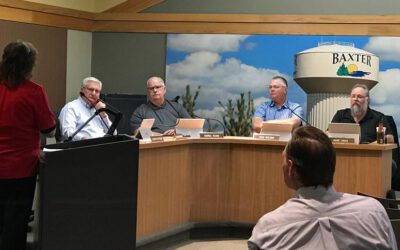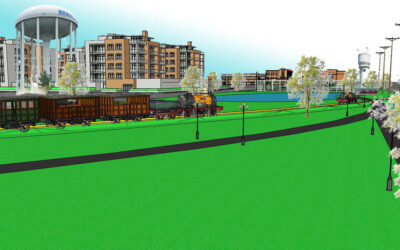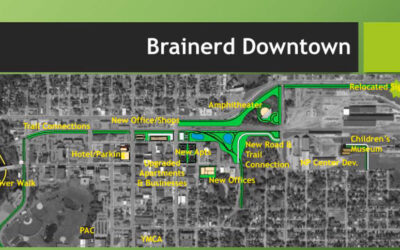Downtown parking solutions and tax increment financing districts became the focal points of a presentation on Brainerd’s River to Rail initiative in front of city council members Monday, April 29.
The River to Rail initiative seeks to revitalize the area between the Mississippi River and the Northern Pacific Center, and from Washington Street to Oak Street.
Efforts aim to establish “engines,” or project themes centering around arts and culture; trails, parks and community space; comprehensive planning and infrastructure; existing businesses and housing; and development and redevelopment. The initiative’s ultimate goal is to offer incentives to grow the taxbase in the project area and attract workers to relocate there.
Project year in review
Bruce Buxton, who spearheaded the initiative along with the Brainerd Lakes Area Economic Development Corp. back in 2017, took council members through a River to Rail year in review Monday night, highlighting positives signs of development in the project area. Those signs include: ongoing school district projects, Downtown Mall renovations, water tower restoration efforts, exploration of housing projects, the Destination Downtown initiative and events like the summer farmers market. Amid the positivity, Buxton noted only two setbacks in the project area: the closings of Hockey House and Totally Kidz Shop. But on the plus side, he said there seems to be interest in both buildings.Justifying incentives
Examples of potential incentives the city and its River to Rail partners could offer for businesses and developers interested in expanding to Brainerd include waiving fees for city contract licenses and building permits, elimination of sewer and water availability charges, a revolving loan fund through the city and the housing redevelopment authority, Small Cities Development Grants through the HRA, unified fund loans through BLAEDC, and economic development electric rate reduction through Brainerd Public Utilities. In offering these incentives, though, there needs to first be justification, Buxton explained. According to him, the arguments for incentivization include: Aged building infrastructure, including hazardous materials and new codes to comply with; declining downtown property values; high cost of renovation vs. new construction; lack of parking, whether real or perceived; and vacant land downtown. “If you do any of these things, you’d be doing things that other communities have done for decades, not maybe in this exact way,” Buxton said. “Some people will do it different than others, but if you look at downtown Minneapolis, they have encouraged whole blocks to be renovated.” Incentives help both developers and the city, he added, by helping developers achieve reasonable returns on investment and addressing public needs, thus strengthening public/private partnerships.Parking
With the potential for large development projects through the River to Rail initiative comes a greater need for parking, Buxton said. The most recent parking information for Brainerd shows 828 parking stalls downtown. Of those, 387 (46.7%) are private, 106 (12.8%) are leased, 55 (6.6%) are in two-hour lots and 280 (33.8%) are on-street. Many of the on-street spots have two-hour limits 8 a.m. to 6 p.m. Monday through Friday. The data shows about 40% of downtown parking—between Washington and Norwood streets and South Fifth and Eighth streets—is available for public use. “In my view from having looked at this and lived here for over 40 years, I think you somehow have to figure out how to get 300 more stalls in that area or different use of the existing stalls,” Buxton said. Parking problems, he opined, are the most prevalent planning problems in most cities, a point Community Development Director David Chanski agreed with. While downtown parking may become a real issue with large development projects in the future, right now, it may just be a perceived problem, Buxton said, noting residents in rural cities like Brainerd are often in the mindset of not wanting to pay for parking but wanting to park as closely to their destination as possible. “If you travel anywhere—Minneapolis or anyplace else—everywhere you go you pay for parking and you walk,” he said. “Everywhere.” While getting people in the right mindset may be an issue in itself, Buxton also made recommendations the city could use to both increase available parking spots and create new stalls to remedy any parking problems that could arise downtown. Ideas for managing current downtown parking include: Reducing two-hour parking to 90 minutes to increase turnover; restricting overnight parking until 10 a.m. so spots are available for those coming into town for breakfast and other activities in the morning; requiring tenants to lease and use designated parking spots; allowing businesses to share employee parking at off-peak times; and installing parking meters. In terms of creating new parking, Buxton suggested the BNSF Railway property on the east corner of South Eighth and Front streets south of the railroad. A new parking lot there could be leased to downtown tenants, he said. Another idea is to work with Mid-Minnesota Federal Credit Union to reconfigure that parking area and possibly add an underground ramp. Lastly, Buxton recommended working with any private downtown parking lots—like the lot on the corner of South Sixth and Front streets—that are only partially full to figure out how a private owner might be able to share space with the public. Encouraging the ability to walk, bike and use alternative modes of transportation downtown is also an important piece of the revitalization efforts, Buxton added.Tax increment financing
An option for both funding parking or other public infrastructure improvements and adding an incentive for new developments Buxton discussed with the council is establishing tax increment financing districts within the River to Rail project area. TIF is a method of financing using the increased property taxes a new real estate development generates to finance costs of the development. Instead of paying higher taxes immediately upon completion of a new building, a business instead will use those tax savings to cover the costs of demolition, new construction and other development activities. TIF can also be used to finance public infrastructure related to the development. In some cases, the developer would be required to pay for this infrastructure through special assessments or other charges. In other cases, all taxpayers would pay through general city taxes. With several different TIF options available to the city for the River to Rail initiative, Buxton told council members they could use the funds for parking (both new and existing), walking and biking trail improvements or any projects within the River to Rail area. “It could be for a lot of different things,” he said. “You need to figure out what that’s going to be.”What’s next?
Council members did not make any decisions regarding the River to Rail initiative Monday night but seemed eager to discuss Buxton’s suggestions and agreed to schedule a workshop in the future—likely before the 2020 budgeting process—to further discuss the city’s options. Buxton said he and other River to Rail volunteers would be open to attending a council workshop to answer any questions that may arise.



Recent Comments